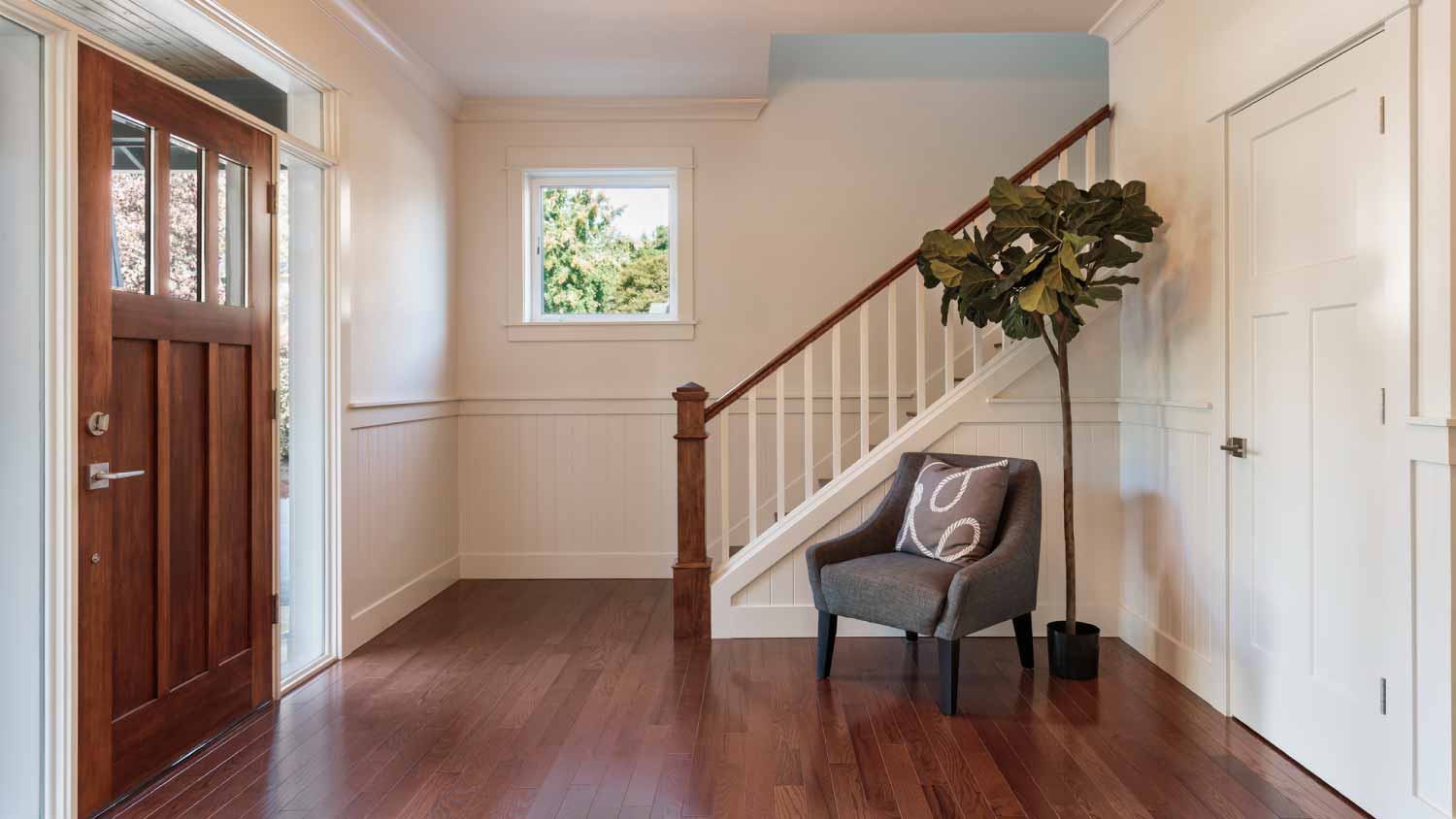How to Remove Vinyl Flooring in 5 Steps
Update your disco-era floors in a flash


- Shop vacuum
- Utility knife
- Putty knife
- Pliers
- 5-in-1 scraper
- Work gloves
- Eye goggles
- Bucket
- Soap
- Wood block
Over time, vinyl flooring can become worn and dated—leaving homeowners deciding to cover up or remove it entirely. To ensure that your new flooring is installed correctly over your subfloor, handy homeowners or local pros can remove vinyl flooring in five steps with a little bit of elbow grease and the right tools.
5 Steps to Remove Vinyl Flooring
Removing vinyl flooring has its own unique challenges, such as getting rid of all the glue and ensuring the floor height remains level, but following the steps below can help alleviate some of these common pitfalls.
Prep for Removal
Before starting your project, you’ll want to ensure there is no asbestos in your vinyl flooring, which was a popular flooring choice from 1950 to 1980. Asbestos fibers can be toxic, so you must get your old vinyl flooring tested before removing it.
You can hire an asbestos removal service in your area for testing, remediation, and removal. Testing for asbestos will run from $150 to $350, and removal can cost $2,000 to $15,000, depending on the size of your project.
Clear Out Your Room and Remove the Trim
Start by removing all furniture and any valuable items out of the room. Place a tarp over any exposed cabinetry. Grab your prybar, rubber mallet, and wood block.
Line up the wood block a few inches from the baseboard and trim. The wood block will serve as a brace between the trim and pry bar.
Place the pry bar where the wall and trim meet and gently use a rubber mallet to loosen the board. Remove the trim with ease, making sure there’s no breakage.
If you’re planning to save the trim and baseboards, place a label on the back of each piece starting with the number one, and move in a clockwise direction for easy installation later.
Pro tip: Use a utility knife to cut through paint, caulk, or any sticky material holding up your baseboards.
Cut Vinyl Flooring Into Strips
 Photo: Leo Malsam / EyeEm / Adobe Stock
Photo: Leo Malsam / EyeEm / Adobe StockMost vinyl flooring uses perimeter installation, which means that only the outside six inches use glue—the rest of the vinyl flooring lays loose or floating on the subfloor. So you’ll want to start in the middle of your floor and locate a spot with no glue underneath.
Grab your utility knife and cut your flooring into 12-inch strips. Pull up each strip gently with a pry bar and roll up the vinyl.
You’ll start to find glue underneath, so you’ll want to use a scraper tool to remove any glue and debris. Try a hammer and chisel to chip away at stuck pieces if your glue is tough to remove.
Remove Stuck Glue
 Photo: CHROMORANGE / Adobe Stock
Photo: CHROMORANGE / Adobe StockIn many cases, there will be excess glue stuck to the subfloor that won’t come off with a scraper tool. Put on your safety goggles and try these helpful ways to remove glue:
Create a mixture of warm water and soap in a bucket. Pour the mixture over the hardened glue and let it sit until the glue softens and becomes easier to remove.
Use a heat gun or a hairdryer to soften hardened areas. Be mindful of the subfloor while using direct heat on the glue, especially if your subfloor is wood.
While most vinyl flooring sits on top of a wood subfloor, you may have vinyl flooring on top of concrete. In this case, the glue may be more challenging to remove.
First, try to use a prybar and scraper tool. Since concrete flooring is tough, you can also try a commercial adhesive stripper or acetone to soften the glue.
And if that doesn’t do the trick, you’ll have to rent a power scraper that will soften the glue and strip the floor.
Pro tip: You can also use a power scraper to remove vinyl and glue from a wood subfloor. However, because it is a powerful tool, you’ll want to make sure you don’t take up the subfloor with the vinyl and glue.
Clean Up and Prepare for the Next Steps
Take all of your vinyl rolls and dispose of them safely. Check with your municipal waste authority to verify if there are any special protocols and if you can recycle the old vinyl material.
Finally, use a broom or a professional shop vacuum to clean up all of the dust and debris in your room.
Once you’re all cleaned up, you’re ready to install your new vinyl flooring.
DIY Removing Vinyl Flooring vs. Hiring a Pro
We recommend that only experienced DIYers who are not afraid of a bit of elbow grease tackle this project. If you’re running short on time and want a pro to make quick work of it as part of a larger project, you may want to consider finding an experienced flooring professional near you.
To replace your vinyl flooring with a new installation, the cost of supplies and materials will run you around $1,200 for sheet vinyl and about $3,300 for luxury vinyl plank or tiles.
The average installation cost runs from $3 to $7 per square foot—about $2,065. You’ll also have to factor in the size of your home, demolition, the cost of materials and supplies, and labor.
Sara Coleman contributed to this article.
Frequently Asked Questions
Linoleum adhesive is quite stubborn, so you may have to try several different methods for removal. You can start with a wallpaper steamer and steam it off or add laundry detergent to water and let it soak into the adhesive. You can try paint thinner directly on the adhesive for about 10 minutes and then wipe away.
How easy it is to remove vinyl floor tiles depends on factors like their age, condition, and the kind of adhesive used. In most cases, removing vinyl flooring involves plenty of elbow grease, but if you’re willing to put in the effort, then it can easily be a DIY project.
Since you can’t recycle vinyl flooring, you can either use curbside pickup or call your municipality or a junk removal company and ask for instructions on pickup or disposal. You can also choose a dumpster rental service, which is especially convenient if you’re in the midst of a large renovation project and have other materials you need to dispose of.

.jpg?impolicy=leadImage)

















